Heading out the door? Read this article on the new Outside+ app available now on iOS devices for members! Download the app.
The best rock climbing shoes in the world aren’t going to do you any good if you can’t reach your route in the first place. Sure, some climbs are just a stone’s throw from the car. Others may require fourth or low fifth-class scrambling to reach the base of the first pitch. Others might have an easy approach, but the descent could involve rappelling, scrambling, or down-climbing back to your start. That’s where approach shoes enter the picture.
Approach shoes are supportive, sticky shoes designed to perform on both trail miles and rock pitches—and look good, too. From backyard crags to backcountry alpine, the best approach shoes will propel a climber anywhere they need to go. Our five testers laced up in 10 new models and dove into adventures from the sun-drenched cliffs of Mallorca to the granite spires of the Bugaboos and back. Here are our six favorite approach shoes of 2025.
Updated April 2025: We added four new approach shoes to this list, including the Arc’teryx Vertex Alpine—our top pick for technical climbing. We’ve also updated pricing and info on shoes that we tested last season but still highly recommend.
At a glance
- Best All-Around: Butora Mousai ($135)
- Best for Alpine Climbing: Arc’teryx Vertex Alpine ($220)
- Best Value: Astral Loyak ($99)
- Best for Cragging: Arc’teryx Kragg ($160)
- Most Durable: La Sportiva TX4 Evo ($169)
- Best Scrambler: Scarpa Gecko LT ($169)
- How to choose
- How we test
- Meet our testers
Don’t miss: The Best Climbing Shoes of 2025
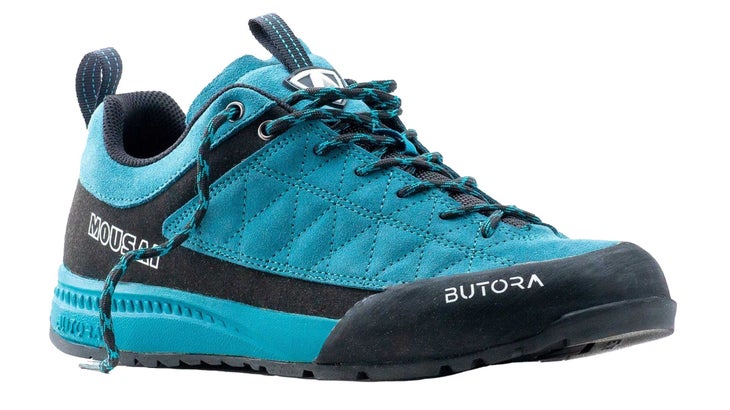
Best All-Around
Butora Mousai
Weight: 1 lb (unisex)
Size Range: US 5-13.5 (men’s) / 6-11.5 (women’s)
Heel-Toe Drop: 5 mm
Pros and Cons
⊕ Comfortable on trail and rock
⊕ Around-town style
⊕ Very affordable
⊕ Highly versatile
⊗ Subpar technical performance
The Butora Mousai shoe nails the balance between affordability, comfort, and vertical and horizontal performance, with a stylish, skate-inspired look, to boot. This unisex shoe was our “most versatile” pick in 2024, and our lead tester, Owen Clarke, kept it on the rankings again, partially because of its very reasonable pricing, and also because out of all the shoes he tested last year, the Mousai is the only one he still wears every week, proving you don’t have to spend $200 for a durable approach shoe.
While a shoe like the Arc’teryx Vertex Alpine is a better choice for climbers looking to maximize performance, the overwhelming majority of us don’t need an approach shoe to climb 5.10 or haul gear 50-plus miles into the backcountry. We need something breathable and comfortable that looks good, smears well, and doesn’t break the bank. That’s the Mousai.
There’s no break-in period and they’re comfortable on moderate trail. This is more of a slabby, friction-based shoe, too roomy for great precision and too soft to stand on fine edges, but the sensitive, pliable midsole, and grippy NEO Fuse outsole still gets the job done on easy rock and approaches. “It’s a great shoe for putting up easy topropes for friends or kiddos, and it does well approaching on slabs or easy fifth class,” reported tester Kelsey Brassuer, a climber and ultrarunner based in Carbondale, Colorado.
She also praised the shoe’s comfort, noting it fit well out-of-the-box and true to size. The suede upper is burly but soft, and the padded mesh tongue is breathable. Clarke has taken these on hikes and backwoods recon scrambles in 80-degree Alabama heat and my feet stay fairly fresh.
The Mousai marries solid performance with an old-school urban look that makes them versatile enough for around-town wear. Note on fit: The Mousai is a good choice for those with wide-feet, but they do run large. We recommend sizing down half a size.
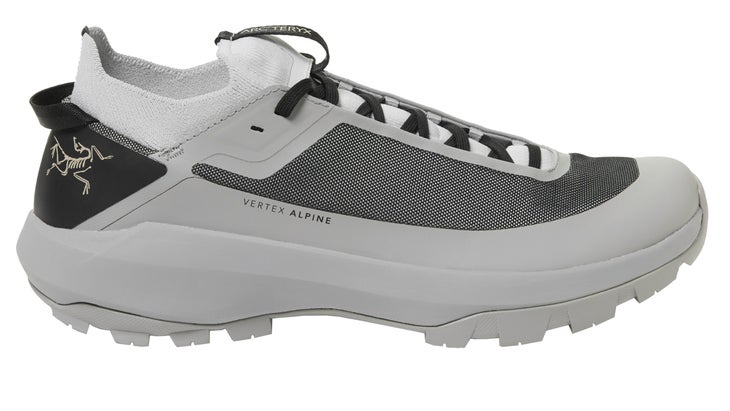
Best for Alpine Climbing
Arc’teryx Vertex Alpine
$220 at REI (Women’s) $220 at REI (Men’s)
Weight: 12 oz
Size Range: US 7-13 (men’s) / 5-10 (women’s)
Heel-Toe Drop: 8 mm
Pros and Cons
⊕ Precise fit
⊕ Stellar grip
⊕ Good hiker
⊕ Stylish
⊗ Expensive
⊗ Narrow fit
Tester and Climbing editor Anthony Walsh calls the Vertex Alpine “a one-shoe wonder, threading the needle between runner and approach shoe.” The Vibram XS Flash 2 sole is built for edging, and also has a flat, smearable toe. Coupled with a lacing harness that dials the fit down over the forefoot, the Vertex Alpine is a very supportive climber, capable of high-precision footwork. The performance doesn’t stop when you hit the trail, either: the cushioned sole and rockered design also let you power through fast hikes.
Our testers appreciated the Vertex’s stretchy, sock-like knit collar, which keeps out gravel and other debris without making the shoe hard to put on. The shoe also proved durable over months of testing thanks to a Matryx upper, consisting of high tenacity polyester coated with polyurethane and a blend of technical yarns like aramid fiber and Kevlar. Our tester pairs showed no signs of wear after 100-plus miles, on missions from friction-based 5.8 alpine scrambles to 30-mile hiking approaches. The Vertex Alpine also gets points for style—both our male and female testers called it the best-looking shoe in their quiver.
Downsides include a high price tag ($220) and a slim, almost rock-shoe-like fit that—while great for performance—borders on the extreme, and may not be comfortable for wide feet. Walsh noted that the shoe stretched enough to become comfortable after a few wears, though he recommended keeping the forefoot’s laces totally slack and only tighten around the ankle unless you’re actually climbing.
Despite the Vertex Alpine being the best technical approach shoe we tested, it also performed well in other areas. It even got Walsh into a high-end nightclub with a strict dress code in Las Vegas. “The Vertex Alpine passed the vibe check,” he said, “and the cushioned, rocker sole provided plenty of comfort for the next four hours on the dance floor.”
Read our longform review of the shoe here.
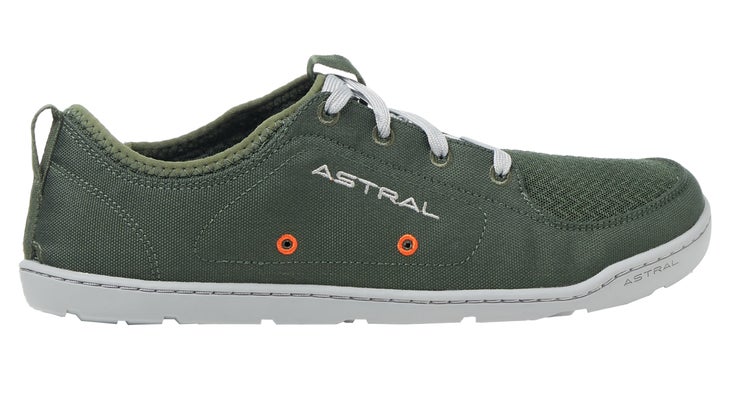
Best Value
Astral Loyak
Weight: 7.4 oz (men’s) / 5.7 oz (women’s)
Size Range: US 8-14 (men’s) / 6-11 (women’s)
Heel-Toe Drop: Zero Drop
Pros and Cons
⊕ Affordable
⊕ Sensitive, soft footbed
⊕ Comfortable heel-strike
⊕ Lightweight
⊗ No support
⊗ Poor climbing performance
In a day and age where it’s hard to find any shoe for under $100, the Astral Loyak defies inflation. Unlike the other shoes on this list, the Loyak isn’t purpose-built for climbers, but it’s the lightest and most breathable model we tested, with a paddle-shaped forefoot that spreads and grips well on loose trail and easy rock alike. This isn’t a mountain shoe, but is a very budget-friendly approacher that’s sensitive and sticky enough to perform on fourth class and low-end, slabby fifth, like Boulder, Colorado’s Flatirons—where tester Matt Samet soloed several hundred feet in his Loyaks without issue.
The Loyaks have clip-loops to attach to a harness, compress well in a pack, and are all-around great for fast and light approaches. Despite their low price and minimalist build, they’ve also held up very well over testing. “I really pounded the hell out of them,” said Samet after three months of testing in the Colorado Front Range, “and they aren’t dinged.”
The Loyaks performed particularly well on loose scree and ball-bearing trails, like the approach to Hillbilly Rock in Colorado. This steep, hillside trail “has eroded into a sketchy trough where the footing is mobile,” Samet explained. “I think you gain 1,200 feet in three-quarters of a mile.” The Loyaks were perfect. They were sticky on the way up, but spread out well on the way down, providing much better purchase in the loose ground than a boot or stiffer, more “built-up” approach shoe.
In addition to lackluster climbing performance, the big downside is that—unless you’re a die-hard member of the barefoot shoe tribe—these won’t have the comfort or support you’ll want for longer approaches or carrying a heavy pack. Still, at $99, it’s hard to complain.
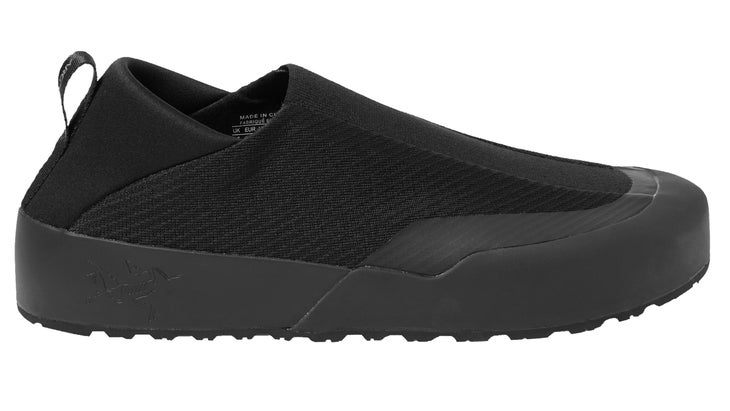
Best for Cragging
Arc’teryx Kragg
Weight: 11 oz (men’s) / 9 oz (women’s)
Size Range: US 7-13 (men’s) / 5-10.5 (women’s)
Heel-Toe Drop: 7 mm
Pros and Cons
⊕ Lightweight
⊕ Breathable
⊕ Collapsible heel
⊗ Expensive
⊗ Limited technical and trail utility
⊗ Not very durable
This plush, cozy slipper may look a bit “Nurse Ratched” (as tester Matt Samet put it), but it’s far and away our favorite shoe for casual cragging. The Kraggs are easy on-and-off, smear well thanks to their Vibram Megagrip outsole, and have cloud-like Contoura foam insole cushions that can be removed and washed.
The coolest feature about the Kraggs is that their heels are built to collapse, so you can stand on them while belaying or hanging out at camp without worrying about deforming the shoe. “I love them at the crag or as recovery shoes in the evening,” said tester Kelsey Brassuer. “They feel super cush underfoot. I could even see packing them in as a camp shoe for a multi-day backcountry trip.”
Despite their slip-on ease, the Kraggs maintain enough stretch in the Spacermesh upper to keep them from sliding around and feeling sloppy on uneven terrain. Testers also appreciated the gently lugged two-millimeter outsole, which provided purchase in loose or sandy soil. Testers found the shoe locked-in enough to handle rappels and descents, but at the end of the day, these are slippers (and at $160, an expensive pair at that). They don’t have enough traction for a dedicated trail shoe. For a comfort-focused crag shoe, however, the Arc’teryx Kragg is as good as it gets.
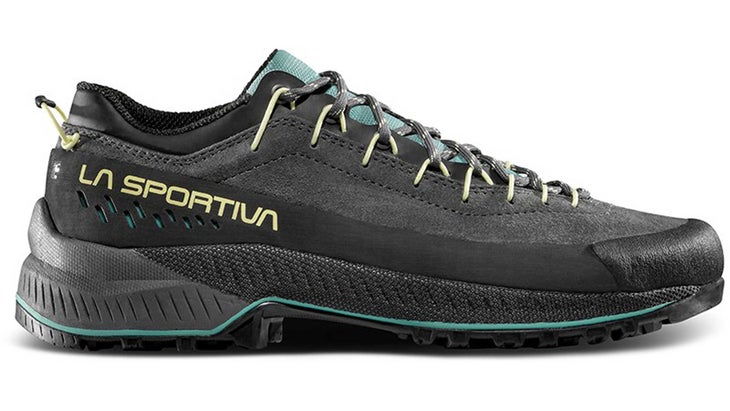
Most Durable
La Sportiva TX4 Evo
$169 at REI $169 at Backcountry
Weight: 14.2 oz (men’s) / 12.1 oz (women’s)
Size Range: US 5-13.5 (men’s) / 5-11 (women’s)
Heel-Toe Drop: 8 mm
Pros and Cons
⊕ Great rock grip
⊕ Secure, easily-calibrated lacing
⊕ Out-of-the-box comfort
⊕ Stiff footbed for edging
⊗ Minimal weatherproofing
The TX4 Evo is a climber’s shoe that excels on rock and trail alike, but is best positioned for technical climbing and shorter approaches.
From the get-go, we were impressed with the leather TX4 Evo’s ability to tackle a variety of terrain. Testers with different foot shapes reported that the shoe fits snugly, locking the foot in place thanks to a Mythos lacing system that not only runs down to the toe but also loops around the back of the heel. As you tighten the TX4 Evo’s forefoot laces, you’re not just locking in your forefoot, but your heel as well. A Vibram Megagrip outsole with three-millimeter lugs provides equally secure grip on trail and rock. Our testers put over 150 miles on the shoes and saw no durability issues.
“Climbers could use this shoe for nearly every style of approach; from casual trails to slabs, scree, talus, and easy technical pitches,” said Colorado-based climber and ultrarunner Kelsey Brasseur.
She reported that the footbed is supportive without feeling stiff, but noted that the sides of the shoe were prone to rubbing on her ankle bones. With that in mind, she recommended the TX4 Evo for outings of eight to ten miles, tops. “If that issue weren’t present, I feel like I could wear them all day,” she said.
Other testers, however, didn’t have issues with hotspots. “I was out-of-the-box impressed,” said Anthony Walsh, Climbing’s senior editor based in British Columbia. “The TX4 Evo fit my slightly wide, slightly high-volume foot extremely well, and was a comfortable companion from the get-go. In fact, my very first hike with the shoe was a steep eight-mile trek into the Bugaboos, and I had no pressure points.”
That said, Walsh agreed with Brasseur that this shoe is best for shorter approaches. “A slightly more rockered outsole would make this shoe more comfortable on flat, non-technical terrain,” Walsh said. “But you’d sacrifice climbing performance—receiving a less stable edging platform—as a result of adding that rockered outsole.”
The principal updates from the existing TX4 are a number of eco-friendly features, primarily the addition of a new resoleable platform, making it easier to resole without damaging the EVA midsole. The shoe also incorporates significantly more recyclable components, including a 100 percent recycled rubber rand and toe cap, laces, tongue, and inner mesh lining. The TX4 Evo is also available in a mid version for $219.
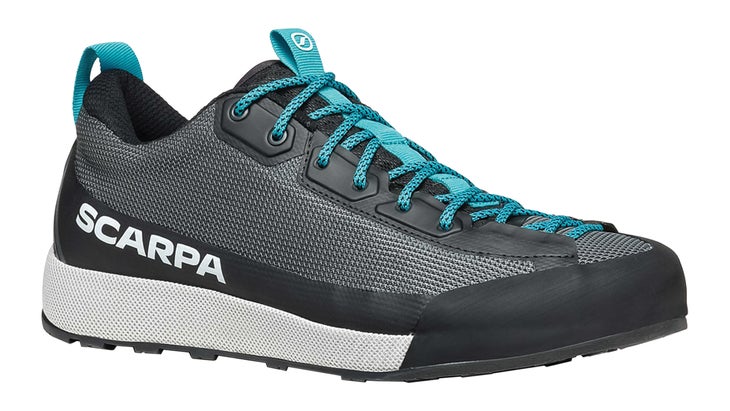
Best Scrambler
Scarpa Gecko LT
$116 at Campsaver (Women’s) $169 at Zappos (Men’s)
Weight: 11.3 oz (men’s), 9.9 oz (women’s)
Size Range: US 7.5-14 (men’s), 5-10 (women’s)
Heel-Toe Drop: 10 mm
Pros and Cons
⊕ Superb support and grip on faces
⊕ Confident, comfortable jamming
⊕ Durable
⊗ Poor grip on trail
⊗ Uncomfy for long hiking approaches
The Gecko LT—a reinvention of Scarpa’s popular and long-standing Gecko—is a climber’s shoe through and through. This techy, stiff, and burly model is our top pick for folks who want to hit the wall and climb moderate fifth-class routes without busting out their rock shoes.
Its lightweight Ripstop upper offers a blend of breathability, abrasion resistance, and protection. A flat last and grippy sole, boosted with sticky toe rubber, excels when smearing, with shallow lugs offering maximum rubber-on-rock contact. Meanwhile, the rigid, supportive build makes the Gecko LT far and away the best edger and jammer on our list, with one tester noting it gave him a “TC Pro–esque feel” during such movements—high praise for an approach shoe.
However, the characteristics of this climbing-heavy build—with its neutral last and low-profile lugs—are just what keep it from performing well on long trail approaches and soft or wet surfaces.. Tester Anthony Walsh said he loved the shoe’s flat last while edging and smearing, “but this also means it doesn’t ‘roll’ with the terrain while walking,” he said. “The lugs, while grippy for climbing, lack meaningful traction while walking downhill on wet, grassy, or muddy trails.”
Still, the Gecko LT is plenty comfortable for short trail approaches and even cruising around town. Aside from its first-rate climbing performance, testers appreciated the shoe’s comfort and durability—specifically its ability to maintain shape and rubber over time and the breathability of the cushioned, perforated tongue.
How to Choose an Approach Shoe: Frequently Asked Questions
What should I look for in an approach shoe?
The approach shoe ecosystem is just as diverse as that of technical rock shoes, perhaps more so. So the first step is setting your goals. Are you looking for a shoe to take you up a dozen pitches of 5.5 while guiding newbie friends at a sport crag? Or are you hoping to clock 10-plus miles of approach on your way to your next big wall? If the former, you’ll want to prioritize technical climbing ability. If the latter, underfoot cushioning and durability will likely be more important.
First scan lug depth and placement. Deeper lugs provide better traction on trail, but often sabotage rock grip, particularly when placed on the forefoot. Shallow lugs or dot rubber on the forefoot, and deeper lugs on the heel can provide a best of both worlds. Next, examine rubber coverage. Shoes without toe caps and heel coverage won’t stand up to climbing abuse. If you’re planning to jam cracks, you’ll also want a more extensive rand on the sides.
Also consider durability and breathability in the upper. Overall, suede and leather tend to be more durable, but there are also many modern synthetics that can compare, particularly knit and engineered mesh blends, where traditional polyester or nylon is reinforced with hardened fibers like aramids or Kevlar. In addition to being vegan-friendly, synthetic materials are often lighter, and may offer specific niche advantages, like water resistance.
Rubber is also worth considering from a durability perspective. There’s no hard and fast rule here, and almost all shoe brands have their own proprietary rubber formula that they swear by, but thinner, more pliable and sensitive rubber soles are typically less durable, prone to sloughing over time. If you want an approach shoe that can climb well, you may want to opt for stickier rubber. If you’d rather your shoe hold up on the trail, a denser rubber compound and thicker outsole is a safer choice.
How to size an approach shoe?
Approach shoes should fit snug in the heel with no slippage, have a comfortable toe box, and provide a precise fit that wraps around the forefoot. Your toes should gently touch the edge of the shoe, or be a hair’s-breadth back. In general, you want as little blank space as possible in these shoes—like a climbing shoe—although this will vary based on the type of approacher your purchasing. A technical climber like the Gecko LT should be almost form-fitting, with toes powered forward, while a more trail-based shoe like the Vertex Alpine will work best with some breathing room and toe splay. When trying them on, wear the same socks you’d wear with a hiking shoe, and walk around on an incline to simulate real-world conditions.
For techy models, try all the movements you’d perform in rock shoes: edging on the toe and sides, jams, smears, heel and toe hooks. Stiff footbeds are extra-important in climb-focused models, providing support for edging to make up for the lack of sensitivity. But how you size your shoe is up to you. Some people size down a half size or a full size from their street climbing shoe to ensure a snug, performance fit, but there isn’t a hard and fast “downsize” rule like there is with many rock climbing shoes. A tighter approach shoe will typically climb better, a roomier one will typically hike better.
What’s the difference between hiking shoes and approach shoes?
At first glance, hiking shoes and approach shoes appear quite similar. Both are low-cut and lightweight, designed to provide traction on a variety of surfaces. The biggest difference with an approach shoe is that it’s designed to perform on technical rock as well.
Approach shoes typically have sticky rubber soles and a shallow lug pattern that won’t interfere with rock grip. They also tend to have more extensive rubber rand with coverage on the toe, heel, and/or sides of the foot. Some approach shoes—like the Kragg or Mousai—will be more sensitive and pliable than the average hiking shoe to facilitate comfort and smearing, while more technical models—like the Gecko LT and Vertex Alpine—will be stiffer to boost edging performance.
Beyond this, differences will vary depending on the model, but approach shoes are usually lighter and less weatherproof than hiking shoes. Approach shoes also tend to be less durable, due to the softer rubber compounds used to offer better rock grip, but some models, like the Mousai and Vertex Alpine, hold up exceptionally well.
Can you run in approach shoes?
You can certainly trail run in approach shoes, although they aren’t designed for it. You’ll likely run into issues primarily with comfort and traction. Most approach shoes don’t have aggressive lugs, so they may falter when moving fast on mud, dirt, or other loose surfaces. An approach shoe midsole also isn’t designed for the high-impact nature of running and won’t absorb your stride as well as a trail running shoe, so you may find yourself with heel and forefoot pain on longer runs.
Every runner is different. Many climbers run in their approach shoes regularly without issue. If you’re in search of an approach shoe that can pull double-duty as a trail-running shoe, look for a lightweight model with capable lugs and good impact absorption. The Arc’teryx Vertex Alpine is our top choice in that department.
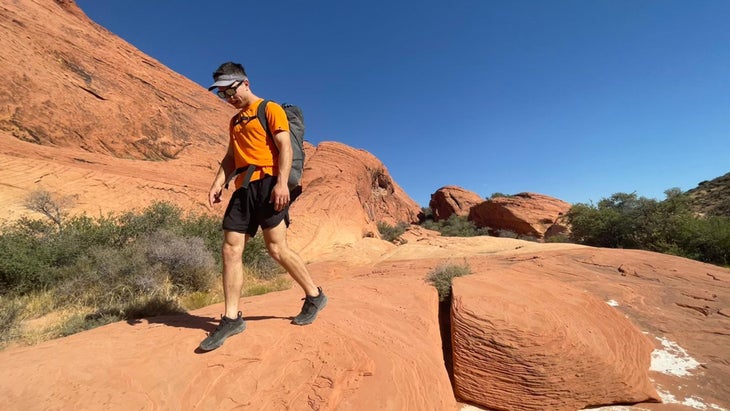
How We Test
- Number of testers: 5
- Number of products tested: 20
- Total miles: 500
- Total rock pitches: 50
- Lowest elevation tested: -100 feet (Rappelling into caves in Alabama)
- Highest elevation tested: 14,009 feet (Thunderbolt Peak, Sierra Nevada)
Five male and female testers put ten models to the test on hikes, scrambles, and rock climbs from the sandstone of Nevada’s Red Rock Canyon State Park to the granite of the High Sierras, the Colorado Western Slope, Bugaboos, and more. In total, we put over 500 trail miles on these models, thousands of feet of technical scrambles, and around 50 guidebook pitches of technical rock. Along the way, we judged each shoe for its weight, breathability, weatherproofing, durability, material construction, price, and aesthetic appeal.
We looked at traction on dirt, mud, and other trail surfaces, as well as loose scree and talus. We also tested grip and performance on a variety of technical climbing maneuvers: jamming, edging, smearing, and hooking. In addition to the shoes new on the market for 2024/25, we also considered tried-and-true favorites from years past, some of which are still in our testers’ quivers. Then, at the end of the season, we gathered all that data and collated it into the reviews you see here.
Meet Our Testers
Owen Clarke is a freelance climbing writer who has been tying in since 2011. After early years pioneering choss in Alabama, Owen has climbed and lived all over the map, most recently in Las Vegas, Nevada.
Kelsey Brassuer is a climber and ultra-runner based in Carbondale, Colorado. She’s been climbing for nearly two decades and is experienced in multiple disciplines, from alpine trad to desert splitters to sport.
Anthony Walsh is a Senior Editor at Climbing magazine whose favorite part of the job is gear testing. He loves long approaches almost as much as he loves granite hand cracks (or the offwidths he can climb in approach shoes).
Szu-ting Yi is an AMGA Rock Guide and SPI Provider. She began guiding and instructing in 2008 and has authored five books on climbing. Following seven years of vanlife, she now resides in Las Vegas with her husband and two cats.
Matt Samet is a climber of 36 years based with his family outside Boulder, Colorado, where he works as a freelance writer and editor. He’s been gear testing for 20 years and particularly enjoys testing rock and approach shoes on the local sandstone of the Flatirons. Samet is the author of the memoir Death Grip and the Climbing Dictionary.
More Gear Reviews
The Best Climbing Shoes of 2025
The Best Ropes for Ice, Rock, and Gym Climbing
